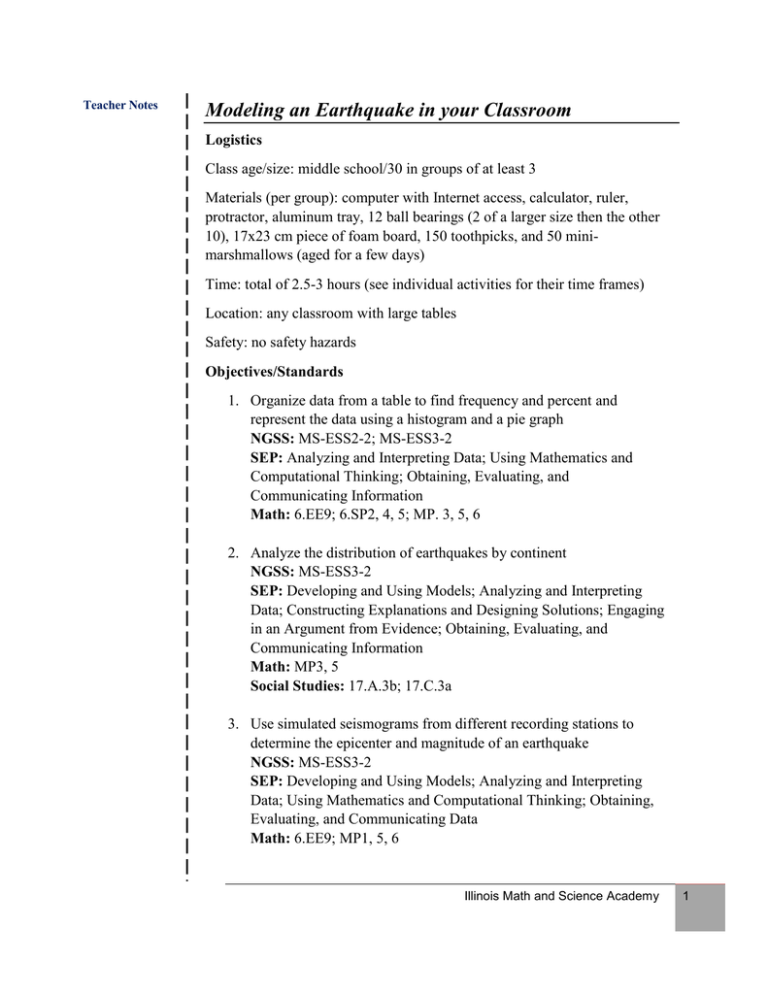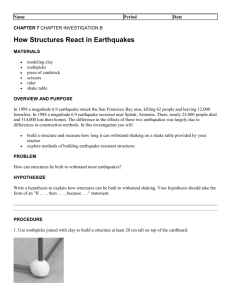
Teacher Notes
Modeling an Earthquake in your Classroom
Logistics
Class age/size: middle school/30 in groups of at least 3
Materials (per group): computer with Internet access, calculator, ruler,
protractor, aluminum tray, 12 ball bearings (2 of a larger size then the other
10), 17x23 cm piece of foam board, 150 toothpicks, and 50 minimarshmallows (aged for a few days)
Time: total of 2.5-3 hours (see individual activities for their time frames)
Location: any classroom with large tables
Safety: no safety hazards
Objectives/Standards
1. Organize data from a table to find frequency and percent and
represent the data using a histogram and a pie graph
NGSS: MS-ESS2-2; MS-ESS3-2
SEP: Analyzing and Interpreting Data; Using Mathematics and
Computational Thinking; Obtaining, Evaluating, and
Communicating Information
Math: 6.EE9; 6.SP2, 4, 5; MP. 3, 5, 6
2. Analyze the distribution of earthquakes by continent
NGSS: MS-ESS3-2
SEP: Developing and Using Models; Analyzing and Interpreting
Data; Constructing Explanations and Designing Solutions; Engaging
in an Argument from Evidence; Obtaining, Evaluating, and
Communicating Information
Math: MP3, 5
Social Studies: 17.A.3b; 17.C.3a
3. Use simulated seismograms from different recording stations to
determine the epicenter and magnitude of an earthquake
NGSS: MS-ESS3-2
SEP: Developing and Using Models; Analyzing and Interpreting
Data; Using Mathematics and Computational Thinking; Obtaining,
Evaluating, and Communicating Data
Math: 6.EE9; MP1, 5, 6
Illinois Math and Science Academy
1
Teacher Notes
4. Design and build an “earthquake proof” structure and a shake table to
test the designs
NGSS: MS-ESS3-2; MS-ETS1-1, 2, 3, 4
SEP: Asking Questions and Defining Problems; Developing and Using
Models; Planning and Carrying Out Investigations; Analyzing and
Interpreting Data; Constructing Explanations and Designing Solutions;
Engaging in an Argument from Evidence; Obtaining, Evaluating, and
Communicating Information
Math: MP1, 3, 5, 6
Social Studies: 17.C.3a
References to Common Core are adapted from NGA Center/CCSSO © Copyright 2010. National Governors Association Center for
Best Practices and Council of Chief State School Officers. All rights reserved.
References to Next Generation Science Standards are adapted from NGSS. NGSS is a registered trademark of Achieve. Neither
Achieve nor the lead states and partners that developed the Next Generation Science Standards was involved in the production of,
and does not endorse, this product.
Introduction
With the increase in seismic activity in the area, we would like suggestions on
how to construct new buildings to better survive a seismic event. We know
that Illinois is not as active as other parts of the country, but we know there
have been seismic events in the past and recently. Please help us take the
proper amount of precaution based on the severity of the threat to our area.
Activity/Activities
Activity One: Significant Earthquakes Around the World
Time: 45-60 minutes
Materials: Computer with Internet access, calculator, ruler, protractor
Objectives: 1 and 2
Guiding Question: Where do earthquakes take place and what are their
strengths?
Illinois Math and Science Academy
2
Teacher Notes
1. Go to the website: earthquake.usgs.gov/earthquakes/map/. Work with
a partner and use this earthquake magnitude data from the past week to
complete the data table below.
Significant Earthquakes from the past week Ordered by Magnitude
MAGNITUDE
TALLY
FRACTION PERCENT
OF A
CIRCLE
>8.4
8.0 – 8.4
7.5 – 7.9
7.0 – 7.4
6.5 – 6.9
6.0 – 6.4
5.5 – 5.9
5.0 – 5.4
4.5 – 4.9
4.0 – 4.4
3.5 – 3.9
3.0 – 3.4
2.5 – 2.9
< 2.5
TOTAL
Illinois Math and Science Academy
3
Teacher Notes
2. Next you will design a pie graph using the Significant Earthquakes from
the past week Data Ordered by Magnitude data table “° of a Circle”
column. Don’t forget a title.
Illinois Math and Science Academy
4
Teacher Notes
3. Finally, you will make a histogram of the data. Histograms show
probability distributions in the form of a graph. Think of a histogram as
a “sorting bin”. The set of data representing one variable is sorted by
placing each piece of data into one of the “bins”.
4. To make the histogram for the Significant Earthquake data, the
vertical axis represents the frequency of earthquakes and the horizontal
axis represents the magnitude ranges.
5. The magnitudes are grouped into bins that are next to one another. For
example, the horizontal axis might start with a bin labeled 2.5, the next
bin 3.0, the next 3.5 and so on. The first bin includes magnitudes 2.52.9, the second 3.0-3.4 and so on.
HISTOGRAM of SIGNIFICANT EARTHQUAKES
Illinois Math and Science Academy
5
Discussion/Conclusion:
Teacher Notes
1. What magnitude appears to be the most frequently occurring?
2. From the data, make a prediction about the number of earthquakes
with a magnitude greater than or equal to 8.0 that will occur during the
next ten years? Explain how you made your prediction.
3. Are there certain regions of the Earth that are prone to destructive
earthquakes? What evidence do you have to support your answer?
4. Describe the strong and weak points for suing a histogram to display
the data and do the same for a circle graph.
Activity Two: Virtual Earthquake
Time: 30 minutes
Materials: Computer with Internet access
Objective: 3
Guiding Question: How are earthquakes studied and how do they cause
damage?
1. Go to the website
http://www.sciencecourseware.org/VirtualEarthquake/
2. If you are using an iPAD, click on “Execute Virtual Earthquake” at the
bottom of the web page. For any other computer, click on the word
“HERE” in the second paragraph. The two versions both have students
identify epicenters and magnitudes, they give different amounts of help
with reading the graphs for the students.
Discussion/Conclusion:
1. What are the different waves that are generated by an earthquake and
how do they move the earth?
Illinois Math and Science Academy
6
Teacher Notes
Activity three: Let’s Get Ready to Tumble
Time: 60-90 minutes
Materials (per group): Aluminum tray, 12 ball bearings (2 of a larger size
then the other 10), 17x23 cm piece of foam board, 150 toothpicks, 50 minimarshmallows (aged for a couple of days), shake table
Objective: 4
Guiding Question: What are the characteristics of an “earthquake proof”
structure?
1. Distribute the materials and issue the challenge. The students must
construct a building using only the toothpicks and marshmallows. The
building must be at least 12” tall and will be shaken on the shake table
for 1 minute.
2. You can either have them first construct their building and then their
own shake table or have them make the shake table first. The 2 larger
ball bearings are to allow the foam board to give an up and down
component and not just horizontal shaking.
3. Have groups work and rework their designs. When time is up, have
each group come up and the teacher will attempt to destroy the design
using the shake table.
4. The class can rate the building at the end on a scale of 1 to 5.
Discussion/Conclusion:
1. How well did your building survive the earthquake?
2. What changes did you make from your first prototype to your final
design?
3. Now that you saw what happened to your building, what further
changes would you make if you had another chance?
4. Which design features from the other groups were the most
successful? Which were the least successful?
Illinois Math and Science Academy
7
Conclusion
Teacher Notes
What curriculum do you see these activities cover?
What about disiciplines other than science?
Additional Resources:
World’s largest shake table:
http://www.strongtie.com/about/research/capstone.html?source=hpnav#
Build your own shake table:
http://www.teachengineering.org/view_activity.php?url=collection/cub_/activ
ities/cub_seismicw/cub_seismicw_lesson01_activity1.xml
http://school.discoveryeducation.com/lessonplans/pdf/earthquakeproof/earthq
uakeproof.pdf
Illinois Math and Science Academy
8





